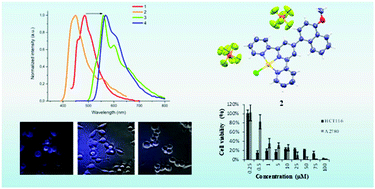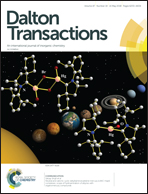Spectroscopy, electrochemistry and antiproliferative properties of Au(iii), Pt(ii) and Cu(ii) complexes bearing modified 2,2′:6′,2′′-terpyridine ligands†
Abstract
Structural, spectroscopic and electrochemical properties of six complexes [AuCl(L1)](PF6)2·CH3CN (1), [AuCl(L2)](PF6)2 (2), [PtCl(L1)](BPh4)·CH3CN (3), [PtCl(L2)](SO3CF3) (4), [CuCl2(L1)] (5) and [CuCl2(L2)]·CH3CN (6) with modified 2,2′:6′,2′′-terpyridine ligands, 4′-(4-methoxyphenyl)-2,2′:6′,2′′-terpyridine (L1) and 4′-(4-methoxynaphthalen-1-yl)-2,2′:6′,2′′-terpyridine (L2) were thoroughly investigated and a significant role of the substituent (4-methoxyphenyl or 4-methoxynaphthalen-1-yl) and the metal center was demonstrated. The naphthyl-based substituent was found to increase the emission quantum yield of the luminescent Au(III) and Pt(II) complexes. Furthermore, the antiproliferative potential of the reported complexes was examined towards human colorectal (HCT116) and ovarian (A2780) carcinoma cell lines as well as towards normal human fibroblasts. The Au(III) complex 2 and Cu(II) complex 5 were found to have a higher antiproliferative effect on HCT116 colorectal and A2780 ovarian carcinoma cells when compared with the Pt(II) complex with the same ligand (4). The order of cytotoxicity in both cell lines is 2 > 6 > 1 > 3 > 4. Complex 2 seems to be more cytotoxic towards HCT116 and A2780 cancer cell lines with IC50 values 300× and 130× higher in normal human fibroblasts compared to the respective cancer cells. The viability loss induced by the complexes agrees with Hoechst 33258 staining and the typical morphological apoptotic characteristics like chromatin condensation and nuclear fragmentation and flow cytometry assay. The induction of apoptosis correlates with the induction of reactive oxygen species (ROS). Fluorescence microscopy analysis indicates that after 3 h of incubation, complexes 1–4 are localized inside HCT116 cells and the high levels of internalization correlate with their cytotoxicity.



 Please wait while we load your content...
Please wait while we load your content...